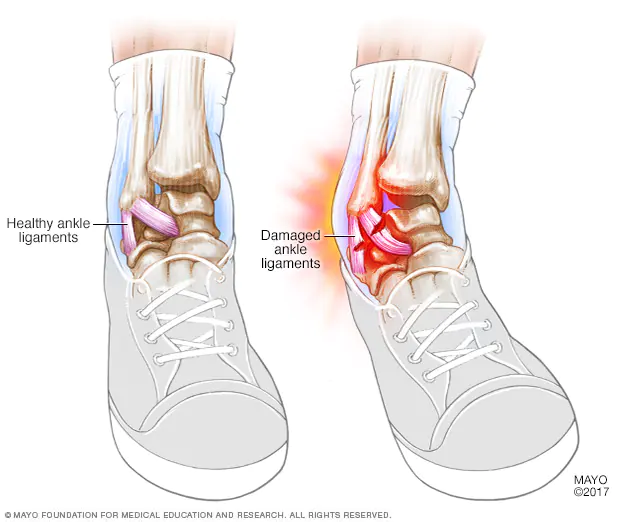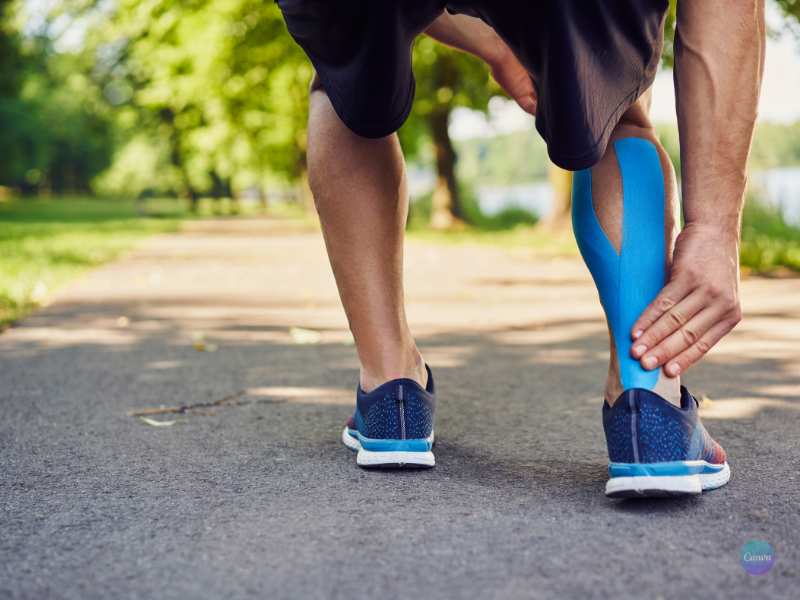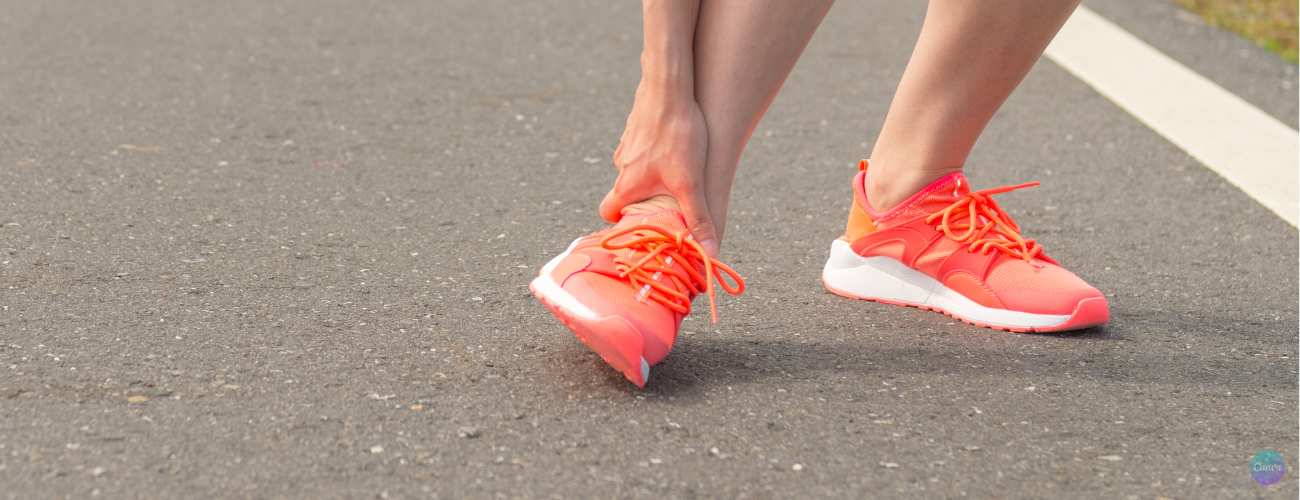Ankle and Achilles tendon injuries in runners
Do you like to run but have ankle problems? Do you often sprain your ankle or have Achilles tendon pain? You're not the only one; a lot of runners go through ankle injuries; it's the second most common injury. In this article, you will learn a lot of relevant and interesting information about Achilles tendinopathy and ankle sprains.
Ankle injury
Why does my ankle hurt from running?
Ankle pain can have many causes. Chronic ones can include arthritis, general overuse, or the gradual development of inflammation. More often, runners suffer from acute ankle injuries, from the most common ankle sprain to less common fractures or ligament injuries. In any case, it is important to visit a surgical, orthopaedic, or trauma clinic for help with a proper diagnosis.
What's an ankle sprain?
An ankle sprain is an acute injury caused by improper footing, typically on the malleolus side of the foot. It is experienced by around 80% of people, and about 85% are purely damaged soft structures, mainly ligaments. Less than 15% are accompanied by a fracture. Depending on the severity of the tendon injury, the orthopaedic surgeon assigns a class. Class 1 means ligament strain, class 2 means micro tears, and class 3 means torn ligaments (1).
How do I know if I have a sprained ankle?
In most cases, the injury is preceded by a bad and painful footfall. Swelling, pain in movement, and bruising come relatively quickly. If you have these symptoms, you need to undergo an X-ray to rule out a fracture (1).

Source: www.mayoclinic.org
How to speed up the treatment of a sprained ankle?
In order for the ankle to heal as quickly as possible, it is necessary to follow a few principles. At least in the first three days after the injury you need to give the ankle absolute rest, you can add icing, pressure bandaging of the limb and elevation of the limb. Combining these elements should reduce soreness, reduce swelling and promote healing. Pain and inflammation can be prevented by taking anti-inflammatory pain medications such as ibalgin or diclofenac, but at the risk of developing stomach upset (1), (2).
Studies have shown that it is optimal to start rehabilitating the ankle after 2 weeks of rest from the injury to return to sport as quickly as possible. It is best to consult a physiotherapist about exercises and to be aware of your pain and discomfort to avoid aggravating the situation. Rehabilitation will probably look like training the range of motion in the ankle and stretching and strengthening the surrounding muscles so that the ankle does not become stiff (1).
When can I start training again?
This question must be answered on a case-by-case basis. In general, a light sprain (class 1) should be ready for gradual loading after 2 or more weeks. A severe ankle sprain (class 3) may be ready for weight bearing in as little as 6 weeks. Taking into account the degree of injury, it is safe to say that 2–6 weeks is the minimum timeto keep the ankle at rest (1).
Achilles tendon injury
The Achilles tendon attaches the calf muscles to the heel bone. It is the strongest tendon in humans, and we use it with every step or jump we take. With prolonged, high loads, it happens that it gets injured. Chronically, Achilles tendinopathy subsequently develops due to constant high overload, and acutely, the tendon may tear or rupture (3).
Achilles tendinopathy
Achilles tendinopathy - what is it?
This is a very painful, chronic tendon injury. It is typical for athletes, especially runners. In one study, up to 83% of middle-distance runners described experiencing pain and symptoms characteristic of this injury in their lifetime. And about 30% of those so injured described pain in both legs (4).

Source: www.canva.com
How do I recognize Achilles tendinopathy?
Achilles tendinopathy is manifested by pain, swelling, and loss of strength. Morning stiffness and tendon pain to the touch are common. Inflammation and, therefore, redness and increased temperature at the tendon site may or may not be present. If it were inflammation, the condition would more accurately be called tendinitis. A detailed examination of the tendon may reveal thickening of the tendon and changes in the tissue at the protein level (4).
What is the cause of Achilles tendinopathy?
As with most runners injuries, repeated mechanical overuse without sufficient rest and recovery time is to blame. Typically, the injury occurs in runners who have increased their training intensity above their norm in recent weeks (4).
Duration and method of treatment
Achilles tendinopathy can be treated for up to a year. The problem is that there has been some degree of pathological rebuilding of the tendon, and it takes a long time to return to a painless state during sports. The best method of treatment is rehabilitation and gradual loading of the tendon. Exercises that may be prescribed are, for example, lifting the toe up and down in a seated position, repeatedly standing on your toes and back on your heels over time, initially on both feet and with progress on one foot, and eventually gradually loading the tendon in sport. We must warn you that this process will take a few weeks, and it is not a good idea to rush your recovery. Always consult the proper rehabilitation exercises and gradual loading with your doctor or physiotherapist (4).
References:
- Gaddi, Diego et al. “Acute Ankle Sprain Management: An Umbrella Review of Systematic Reviews.” Frontiers in medicine vol. 9 868474. 7 Jul. 2022, doi:10.3389/fmed.2022.868474
- Ortega-Avila, Ana Belen et al. “Conservative Treatment for Acute Ankle Sprain: A Systematic Review.” Journal of clinical medicine vol. 9,10 3128. 27 Sep. 2020, doi:10.3390/jcm9103128
- Järvinen, Tero A H et al. “Achilles tendon disorders: etiology and epidemiology.” Foot and ankle clinics vol. 10,2 (2005): 255-66. doi:10.1016/j.fcl.2005.01.013
- Silbernagel, Karin Grävare et al. “Current Clinical Concepts: Conservative Management of Achilles Tendinopathy.” Journal of athletic training vol. 55,5 (2020): 438-447. doi:10.4085/1062-6050-356-19
Image sources:


 CZK
CZK
 EUR
EUR
 EUR
EUR








